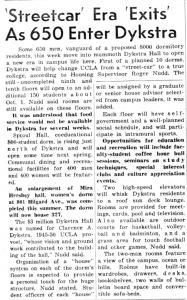I don’t need to tell you that living off campus, especially in North Village, is not the same as living on the Hill.
My roommates (there are far too many) and I commiserate over high rent, a too-happy building manager and instant ramen-heavy, nutrient-low diets.
But these are the natural consequences of leaving the Hill, an ongoing project in reconciling student life with three-star hotel-like luxury. It wasn’t always like that, though.
When Dykstra Hall opened its doors Sept. 15, 1959, The Bruin reported that, according to then-Housing Supervisor Roger Nudd, “Dykstra will help change UCLA from a ‘street-car’ to a true college.”
The idea of UCLA as a “streetcar” college might lead you to believe electric streetcars once zipped up and down Bruin Walk, similar to the streetcars that once carted passengers around Los Angeles, but what The Bruin alluded to was UCLA’s existence as a primarily commuter campus.
Today, less than 5,000 undergraduate commuters get to campus by car, but before the creation of Dykstra, Rieber, Sproul and Hedrick Halls from 1959 to 1963, UCLA was a campus students drove – not walked, biked or hoverboarded – to.
Dykstra’s opening was a turning point for the Hill, signalling UCLA’s transformation from a commuter to residential campus. It was the first installment in a series of dormitories intended to house 8,000 students, a significant portion of the near-12,000 students that live on the Hill today.
That number is about 40 percent of our current undergraduate population. For contrast, the enrolled undergraduate population in 1959 was 11,391.The planned expansion could have housed 70 percent of 1959’s undergraduate population.
Dykstra and the dorms to come were also significantly different dormitories from existing on-campus living accommodations, such as the women’s dormitory, Mira Hershey Hall, which housed 327 after renovations in comparison to Dykstra’s 800, after construction concluded later in 1959. A high-rise designed to house significantly more students, Dykstra came with exciting features like high-speed elevators, a sun deck lounge and floor government.
Of course, the expansion was first intended to house an undergraduate population that would jump up yearly through the ’60s, similar to planned housing additions today to accommodate increased enrollment.
While undergraduate enrollment has skyrocketed to nearly 30,000, making off-campus living options more necessary, UCLA continues to plan as if it is creating a residential community so the university isn’t just where students go to school, but where they live.
Recently completed projects like the constructed Bruin Fitness Center and recently renovated Saxon Suites have continued the crusade for a more glamorous style of student living on the Hill. Ongoing renovations to Delta Terrace and Hedrick Dining Hall all invest high rents and other residential fees in pursuit of providing guaranteed housing to incoming freshmen for four years instead of three.
Just Wednesday morning, UC President Janet Napolitano announced a plan to accelerate housing construction and add 14,000 beds across undergraduate and graduate housing across the various UC campuses.
The housing increase is in part to address the current shortage of affordable housing around different campuses, but also follows the regents’ plan to enroll 10,000 new students across the University over the next three years.
The sprawl of Dykstra, Rieber, Sproul and Hedrick has been condensed as more students move in, but the Hill continues to mirror a more ideal lifestyle than most students would enjoy otherwise – from B-Fit to HBO GO to fresh fruit at Bruin Plate.
And while crowded dining halls, much less increasing enrollment, is already enough cause for current residents to roll their eyes at the line for strawberries and head to the salad bar, residential expansion is unlikely to lower the bar.
Decent rooms, great amenities, relatively individualized service. I think the Hill’s going to keep its three stars.


Nice article!